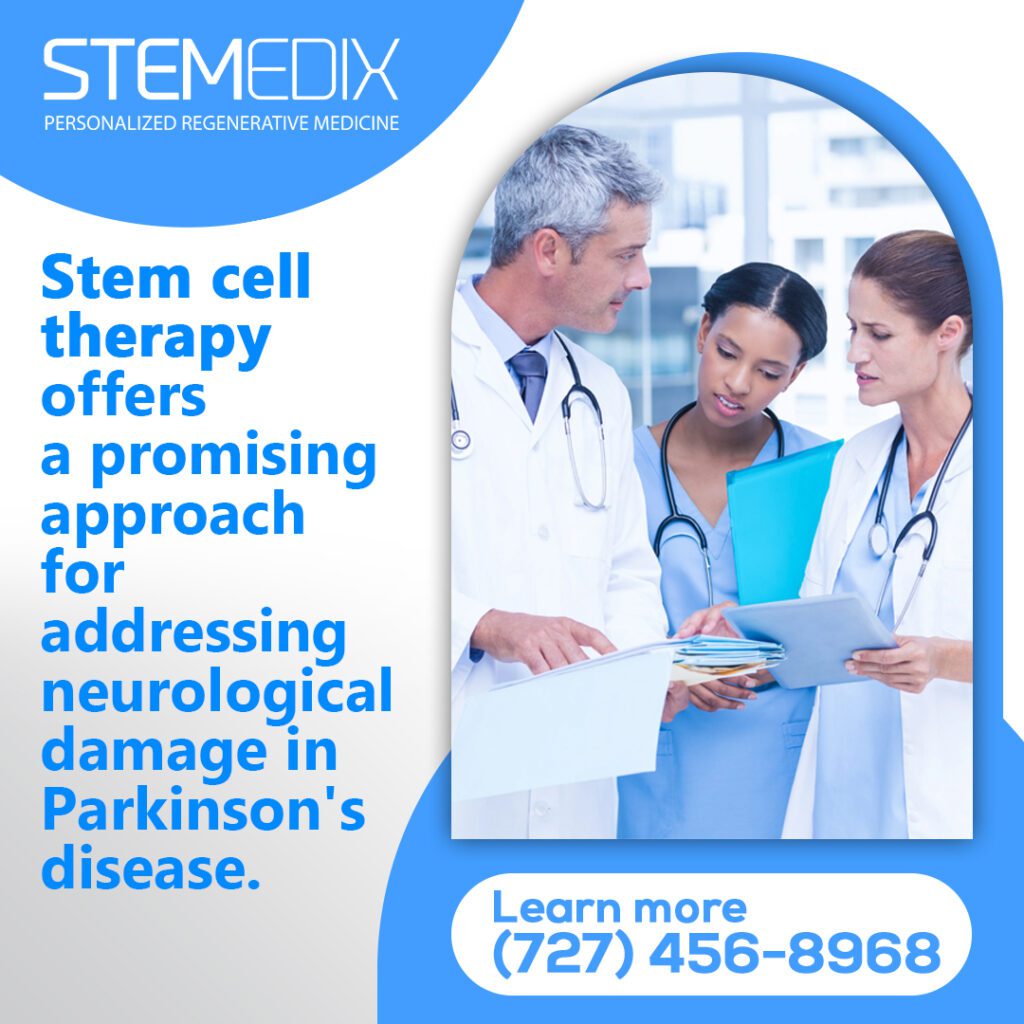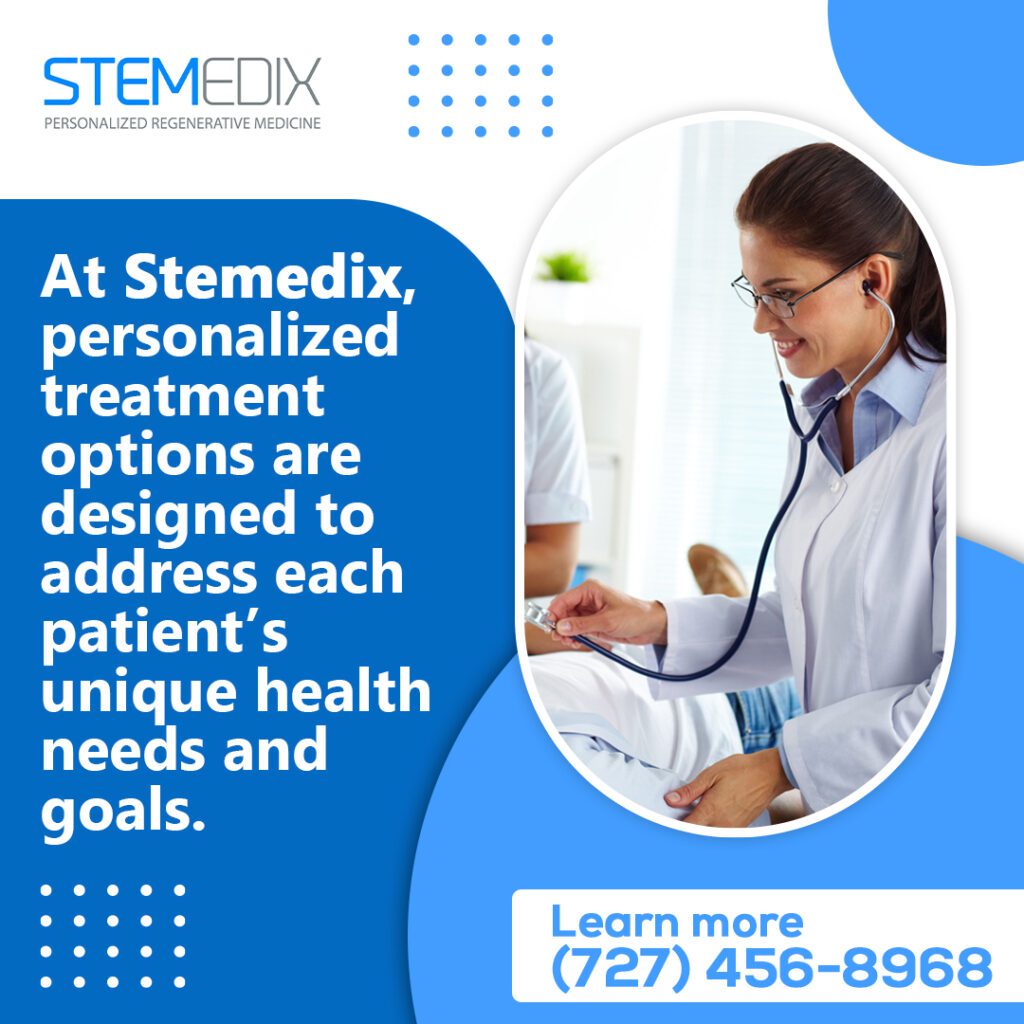
Early Signs and Diagnosis of Parkinson’s Disease and the Potential of Stem Cell Therapy for Parkinson’s
Parkinson’s disease is a progressive neurological disorder that can significantly affect daily life. Understanding its early signs and seeking a timely diagnosis can make a crucial difference in managing this condition. At Stemedix, we recognize the importance of being informed about the symptoms, diagnostic approaches, and available treatments, including the promising field of stem cell therapy. Our goal is to empower you with knowledge, guide you through the complexities of Parkinson’s disease, and discuss the potential of emerging treatments like stem cell regenerative therapy as a complementary option in managing symptoms. By staying vigilant about the early signs, you can take proactive steps toward better health and well-being.
Overview of Parkinson’s Disease
Parkinson’s disease is a neurological condition that mostly affects movement and is complicated and progressing. Understanding Parkinson’s begins with recognizing that it is classified as a movement disorder. This condition stems from the degeneration of specific nerve cells in the brain, significantly impacting your body’s ability to control movements effectively.
Symptoms typically develop gradually and may begin with subtle changes in your daily activities. You might notice a slight tremor in your hand or a change in your walking pattern. As the disease progresses, these symptoms can become more pronounced, leading to difficulties with balance, coordination, and overall motor function. Beyond physical movement, Parkinson’s can also affect emotional and cognitive aspects of life, highlighting its widespread impact on daily living.
The emotional weight of receiving a Parkinson’s diagnosis can be heavy. It’s important to know you are not alone in this journey. Millions of people are going through similar challenges, and there are communities and resources available to support you. Moreover, the exploration of various treatment options, including innovative therapies like stem cell regenerative therapy, is continuously evolving. This progress gives hope to those affected by the disease.
Pathophysiology of Parkinson’s Disease
In Parkinson’s disease, there is a significant change in the brain’s structure and function. Dopamine-producing neurons in the substantia nigra, a part of the brain, gradually die off as part of the pathophysiology. Dopamine is an essential neurotransmitter that aids in controlling emotions and actions. When the neurons that produce dopamine begin to deteriorate, the balance of neurotransmitters in your brain becomes disrupted, leading to the hallmark symptoms of Parkinson’s.
As dopamine levels decrease, you may experience a range of motor symptoms. These can include tremors, stiffness, slowness of movement, and impaired balance. Each person’s experience can vary widely, making it essential for you to pay attention to your unique symptoms and communicate them with your healthcare provider. Understanding the underlying changes in your brain can empower you to engage actively in your treatment and management options.
The loss of dopamine-producing neurons also sheds light on some non-motor symptoms that are often overlooked. These may include changes in mood, sleep disturbances, and even cognitive decline. Recognizing these aspects is crucial for creating an overall management plan.
At Stemedix, we focus on an individualized approach that considers not just the motor symptoms but also the overall well-being of our patients. By understanding the full scope of Parkinson’s disease, you can take a proactive stance in your journey toward improved health and quality of life.

Early Symptoms of Parkinson’s Disease
Motor Symptoms: Recognizing the First Signs
When it comes to Parkinson’s disease, early recognition of motor symptoms can be pivotal. The initial signs are often subtle and may be dismissed as normal signs of aging or fatigue. One of the most common early symptoms you might notice is a tremor, typically starting in the hand or fingers. This involuntary shaking can occur when the hand is at rest and may be more pronounced during periods of anxiety or stress.
Stiffness is another hallmark symptom that can creep in gradually. You may find that your muscles feel rigid, making it difficult to do everyday activities like buttoning a shirt or reaching for objects. This rigidity can also affect your posture and lead to a stooped stance.
Bradykinesia, or slowness of movement, often becomes noticeable as well. You might experience a decrease in your overall speed when walking or performing movements, which can become frustrating and impact your daily activities. Recognizing these motor symptoms early on can be vital for initiating treatment and management strategies, allowing for a better quality of life.
Non-Motor Symptoms: The Hidden Indicators
While motor symptoms tend to grab attention, it is crucial not to overlook the non-motor symptoms that can signal the onset of Parkinson’s disease. You may experience cognitive changes, such as difficulty concentrating or a decline in memory. These cognitive shifts can be concerning and may affect your ability to manage day-to-day responsibilities.
Emotional changes are also significant indicators. Feelings of anxiety or depression can emerge early in the disease and may not be immediately associated with Parkinson’s. It’s essential to understand that these emotional responses are a natural reaction to the changes occurring within your brain and body.
Sensory changes, such as altered sense of smell or changes in vision, can also occur. You might notice a reduced ability to detect odors or a decrease in visual acuity. By identifying these non-motor symptoms, you and your healthcare practitioner may develop a thorough treatment plan that takes into account the disease’s emotional and physical components.
The Importance of Early Recognition
Recognizing the early symptoms of Parkinson’s disease, both motor and non-motor, is critical for several reasons. Firstly, early identification allows for timely intervention, which can lead to improved management of the disease. If you notice symptoms like tremors, stiffness, or changes in mood, it’s essential to consult with your healthcare provider. Early diagnosis can facilitate more effective treatment strategies, including medication and lifestyle adjustments.
Furthermore, being proactive about recognizing symptoms can empower you to take control of your health journey. Engaging in early treatment can help mitigate the progression of symptoms and enhance your overall quality of life. At Stemedix, we believe in a patient-centered approach that emphasizes the importance of awareness and early intervention. By understanding your body and its signals, you can go through this journey more effectively, potentially exploring advanced treatment options such as stem cell regenerative therapy as part of your management strategy.
Diagnostic Approach to Parkinson’s Disease
Initial Patient Evaluation
The journey to a Parkinson’s disease diagnosis starts with an initial evaluation by healthcare professionals. This step is crucial for understanding your symptoms and medical history. During this evaluation, your provider will ask detailed questions about your symptoms, their onset, and how they’ve progressed. You may discuss specific motor symptoms, like tremors or stiffness, alongside any non-motor symptoms, such as mood changes or cognitive issues.
A comprehensive medical history is equally important, as it may reveal genetic predispositions or environmental factors. In some cases, a referral to a neurologist specializing in nervous system disorders will occur. Your input during this evaluation is invaluable; being open and detailed will enable healthcare professionals to make informed assessments and create an effective management plan.
Diagnostic Criteria for Parkinson’s Disease
Once the initial evaluation is complete, healthcare professionals will use specific diagnostic criteria to confirm a diagnosis of Parkinson’s disease. The most widely used set of criteria comes from the movement disorder society-unified Parkinson’s Disease rating scale (MDS-UPDRS). This scale includes several components that assess various aspects of the disease.
The MDS-UPDRS evaluates motor functions, non-motor experiences, and daily living activities affected by Parkinson’s. Healthcare providers will look for key signs, such as bradykinesia, rigidity, and postural instability. A combination of these symptoms, particularly when they are present alongside characteristic tremors, can help solidify the diagnosis.
It’s important to understand that no single test can confirm Parkinson’s disease. Instead, the diagnosis is often based on clinical observation and the presence of specific symptoms over time. Engaging in an open dialogue with your healthcare provider about your symptoms will support accurate diagnosis and help you understand the rationale behind their assessments.
Diagnostic Imaging and Tests
In addition to clinical evaluations, various imaging techniques and tests can aid in diagnosing Parkinson’s disease. While these tools cannot definitively confirm the condition, they help rule out other neurological disorders that may present with similar symptoms. Magnetic resonance imaging (MRI) is often used to examine the brain’s structure, identifying signs of other conditions, such as strokes or tumors, that might mimic Parkinson’s symptoms. Positron emission tomography (PET) scans provide insights into brain function by measuring neuronal metabolic activity. These scans visualize dopamine production and reveal abnormalities linked to Parkinson’s disease.
Additional tests, like blood tests or assessments of olfactory function, can provide further support. Ultimately, your healthcare team will combine clinical evaluations, diagnostic criteria, and imaging results to form a comprehensive diagnosis.
At Stemedix, we understand that navigating the diagnostic process can be overwhelming. You can actively participate in your health journey by encouraging open communication with your healthcare professional and being proactive in talking about your symptoms. Developing a management strategy that may incorporate cutting-edge therapeutic alternatives like stem cell regeneration therapy requires an early and precise diagnosis.
Investigating Stem Cell Therapy for Parkinson’s Disease
Mechanism of Action: How Stem Cells Can Help
Stem cell therapy represents a novel approach to treating Parkinson’s disease, aiming to address the underlying neurological damage that characterizes the condition. The potential of stem cells is seen in their capacity to repair damaged neurons and give the afflicted brain regions their normal function. The hallmark symptoms of Parkinson’s disease, such as tremors and rigidity, are linked to the loss of dopamine-producing neurons. Stem cells are being explored for their potential to support brain repair and reduce symptom severity, though definitive reversal remains a goal for future research.
When administered, stem cells may have the potential to differentiate into neuron-like cells and support neuronal health. Researchers are investigating whether these cells can indirectly aid in restoring dopamine production and improving motor functions. The goal of stem cell therapy for Parkinson’s is not only to alleviate symptoms but also to modify the disease’s progression by repairing the neurological pathways involved.
At Stemedix, we focus on exploring advanced techniques in stem cell regenerative therapy, which are under investigation as potential tools for managing symptoms and improving the quality of life in individuals with Parkinson’s disease. Our approach emphasizes not just treatment but an extensive understanding of how stem cells can work within the body to promote healing and recovery.
Promising Research Findings
Recent studies have indicated the potential benefits of stem cell therapy for Parkinson’s patients in experimental settings. While some participants reported improvements in motor function and quality of life, these results are still under investigation, and more rigorous clinical trials are needed to establish effectiveness and safety. These studies highlight the potential for stem cells to help restore neuronal health, addressing the underlying damage caused by the disease and enhancing the overall functioning of the nervous system.
Preliminary studies have reported some participants experiencing improvements in motor symptoms, such as tremors and dexterity, following stem cell therapy. However, outcomes vary significantly, and further research is needed to confirm these findings and understand long-term effects.
Moreover, ongoing research is exploring various types of stem cells, including mesenchymal stem cells, which have shown promise in modulating inflammation and supporting neuroprotection in the brain. This exciting field of study continues to evolve, with clinical trials underway to further investigate the long-term efficacy and safety of stem cell therapy for Parkinson’s disease.
At Stemedix, we stay abreast of these developments, integrating the latest findings into our patient care practices. By leveraging advanced research, we aim to offer our patients the best possible outcomes through innovative stem cell regenerative therapy.
Stemedix’s Role in Stem Cell Therapy for Parkinson’s Disease
At Stemedix, we are committed to providing personalized treatment options for individuals with Parkinson’s disease, utilizing stem cell regenerative therapy to potentially enhance patient care and improve quality of life. Our approach begins with a comprehensive evaluation of each patient’s unique condition, allowing us to tailor treatments that address their specific needs and health goals.
We understand that navigating the complexities of Parkinson’s disease can be overwhelming, which is why our dedicated team of healthcare professionals is here to guide you every step of the way. From initial consultations to ongoing support, we emphasize compassionate care and patient education, ensuring you have the information and resources needed to make informed decisions about your health.
Through our stem cell therapy programs, we harness the potential of regenerative medicine to help promote healing and recovery. By employing progressive techniques, we strive to optimize the therapeutic benefits of stem cell therapy, aiming to restore function and enhance the overall quality of life for our patients.
At Stemedix, we believe in a future where individuals with Parkinson’s disease can achieve improved health outcomes and live fulfilling lives. Our commitment to innovation and excellence in patient care sets us apart as a leader in the field of regenerative medicine, and we are excited to be part of your journey toward wellness.

Future Prospects of Stem Cell Therapy in Treating Parkinson’s Disease
Advances in Stem Cell Research
The field of stem cell research is rapidly evolving, especially concerning its applications in treating Parkinson’s disease. Current clinical trials are underway, focusing on various aspects of stem cell therapy, including the types of stem cells used, delivery methods, and patient outcomes. These studies aim to determine the most effective ways to utilize stem cells to restore neuronal function and alleviate the symptoms associated with Parkinson’s.
Researchers are exploring various sources of stem cells, such as induced pluripotent stem cells (iPSCs) and mesenchymal stem cells, each offering unique benefits and challenges. For instance, iPSCs are particularly exciting because they can be generated from a patient’s own cells, potentially reducing the risk of immune rejection. Ongoing trials are examining not only the efficacy of these therapies but also the timing of treatment, as an earlier intervention may yield better results in terms of neuroprotection and functional recovery.
At Stemedix, we are closely monitoring these advancements and integrating promising findings into our treatment protocols. By participating in research collaborations and keeping our finger on the pulse of new developments, we aim to provide our patients with pioneering options that could significantly improve their health outcomes.
Safety Considerations and Ethical Implications
As we explore the potential of stem cell therapy for Parkinson’s disease, it is crucial to address the safety considerations and ethical implications of experimental treatments. Many therapies remain unproven and are only available through regulated clinical trials under the oversight of organizations like the FDA, which ensures rigorous safety and efficacy standards.
Ethical considerations also play a vital role in the advancement of stem cell therapy. The sources of stem cells raise important ethical questions regarding consent, sourcing, and potential commercialization.
At Stemedix, we adhere to strict ethical guidelines and practices, ensuring that all our procedures are conducted with transparency and respect for patient autonomy. We prioritize informed consent and actively engage our patients in discussions about the ethical dimensions of their treatment options.
Accessibility of Emerging Treatments
The future landscape of treatment options for patients with Parkinson’s disease is promising, with a growing emphasis on making innovative therapies more accessible. As research progresses and more evidence supports the effectiveness of stem cell therapy for Parkinson patients, we anticipate an increase in treatment centers offering these options. This expansion can help reduce disparities in access to care, ensuring that more individuals benefit from the potential improvements that stem cell therapy can provide.
At Stemedix, we are dedicated to enhancing accessibility for our patients by providing personalized treatment plans that fit individual needs and circumstances. We understand that navigating the healthcare system can be challenging, especially when seeking advanced therapies. Our team is here to assist you through every step, from initial consultations to ongoing support throughout the treatment journey.
As we move forward, the integration of stem cell therapy into the treatment landscape for Parkinson’s disease holds the potential to transform patient care. By focusing on research, ethical practices, and accessibility, we at Stemedix aim to be at the forefront of these developments and are committed to improving the lives of Parkinson’s patients.
Empowering Lives with Stemedix – Navigating the Journey of Parkinson’s Disease
The journey through Parkinson’s disease can be daunting, but understanding the significance of early diagnosis plays a crucial role in improving outcomes for persons affected by this condition. Recognizing the initial symptoms, whether they are motor or non-motor, allows for timely intervention and management, which can significantly enhance the quality of life.
As we look to the future, the promise of stem cell therapy offers new hope. This innovative approach not only aims to address the underlying neurological damage caused by the disease but also holds the potential to restore function and improve patient well-being.
At Stemedix, located in Saint Petersburg, FL, we are dedicated to harnessing the power of stem cell regenerative therapy to provide personalized treatment options that meet the unique needs of our patients. By prioritizing research and ethical practices, we strive to be a leader in advancing care for those with Parkinson’s disease.
If you or a loved one is experiencing symptoms of Parkinson’s disease, early diagnosis and tailored treatment options are crucial. At Stemedix, we specialize in personalized care and stem cell therapy. Contact us today at (727) 456-8968 to learn more about your treatment options.





 St. Petersburg, Florida
St. Petersburg, Florida
